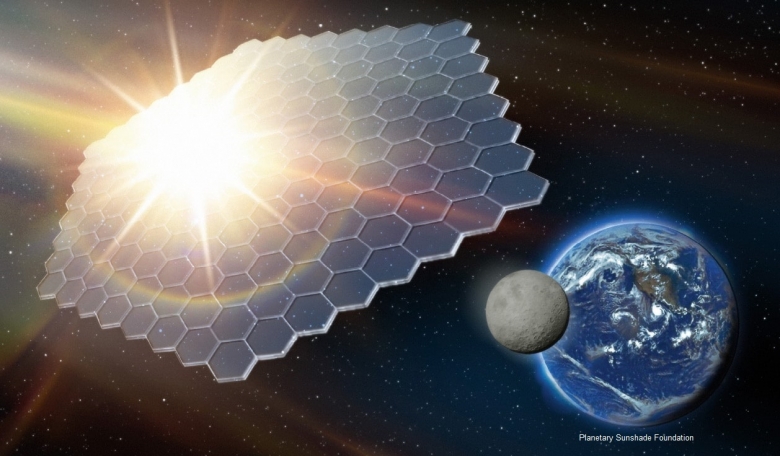The Earth is warming rapidly and anthropogenic climate change is driving higher concentrations of greenhouse gases in Earth’s atmosphere. Left unchecked, the cumulative greenhouse gas burden on Earth’s atmosphere could accelerate in the coming decades and carry temperatures well beyond the 1.5C-2.0C deemed ‘acceptable’ in the Paris agreement. If we are to have any hope of cooling down our planet, perhaps more is called for in addition to ‘going green’. Liz Scott, Research Director of the Planetary Sunshade Foundation, makes the case for geoengineering solutions, and in particular for space sunshades that would intercept some of the Sun’s energy before it reaches Earth.
In 1976, physicist Gerard O’Neill published The High Frontier, which outlined a technically feasible and economically sound plan to solve the greatest problems facing humanity at the time by opening up the ‘high frontier’ of space to human activity.
In the 1970s, these concerns centred around increasing awareness of the limited supply of resources on Earth. Against the backdrop of Malthusian fears of overpopulation, industrial pollution of Earth’s environment, and the lingering effects of the energy crisis, O’Neill proposed the construction of space-based solar power satellites that would supply Earth with all the clean, cheap power it would ever require.
These satellites would be built from lunar resources by a huge workforce of regular people living in Earthlike comfort on enormous orbital habitats. As humans adapted to living in space, more people would choose to leave Earth, and humans could expand further out into the Solar System and, eventually, to the stars. This would ease the burden imposed on Earth by human industrial activity, allowing Earth’s environment to return to Edenic equilibrium.
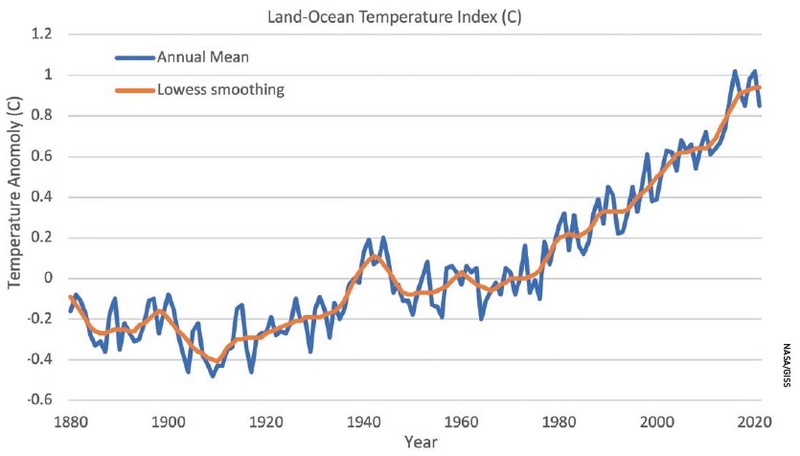 Data source NASA’s Goddard Institute for Space Studies (GISS).
Data source NASA’s Goddard Institute for Space Studies (GISS).
Anthropocene epoch
The revolution in oil exploration also caused a new problem on our finite planet: anthropogenic climate change
Unfortunately, O’Neill’s vision never came to fruition, and some of the reasons for this were financial. The Space Shuttle, which had been expected to drastically lower the cost of access to space, never achieved its cost goals, and new oil extraction technologies, such as fracking, reduced energy costs to below that with which space-based solar power could compete. The revolution in oil exploration also caused a new problem on our finite planet: anthropogenic climate change.
The Sixth Assessment Report from the Intergovernmental Panel on Climate Change (IPCC) makes clear that very little time remains to reduce emissions enough to avoid catastrophic climate change. Space solar power could have averted our climate crisis, and can still offer limitless energy without further compromising our environment, but we will have to do more to restore our climate by mitigating emissions that already exist. The time is right to reinvigorate O’Neill’s vision to address life in the anthropocene.
Climate change is driven by global warming caused by an imbalance in Earth’s energy budget. Energy enters the Earth system from the Sun, and is radiated away through the atmosphere. Greenhouse gasses trap too much energy, and our planet heats up.
This imbalance has caused an increase in global surface temperatures of 1.07C for 2010-2019 compared to the period 1850-1900. On current emissions trajectories, sometime between 2030 and 2050, our atmosphere’s cumulative greenhouse gas burden will drive warming past the 1.5C-2.0C maximum acceptable range (as set by the Paris Agreement).
 NASA’s Solar Cruiser mission, planned for 2025, will demonstrate solar sail propulsion by flying sunward of Sun-Earth Lagrange Point 1 (L-1) and maintaining its position along the Sun-Earth-line using only reflected light for propulsion.
NASA’s Solar Cruiser mission, planned for 2025, will demonstrate solar sail propulsion by flying sunward of Sun-Earth Lagrange Point 1 (L-1) and maintaining its position along the Sun-Earth-line using only reflected light for propulsion.
Seeking solutions
Terrestrially-launched sunshades require only modest advances in technology and could be deployed relatively quickly once a decision is made to proceed with space-based SRM
While there is no moral or practical substitute for reducing greenhouse gas emissions, we must also contemplate how to reduce the effect of an already altered atmosphere. One way is to capture carbon dioxide (CO2) emissions and replace them in the ground, a process which naturally occurs over millennia and might technologically be accelerated to a century. However, with net global emissions continuing to rise, negative emissions technologies are unlikely to prevent severe climate change.
This leads to the second action to address Earth’s energy imbalance: reducing the incoming solar energy through solar radiation management (SRM). SRM is a type of geoengineering and it can be accomplished in two broad ways. The first is to increase the amount of solar energy reflected back to space by increasing Earth’s albedo (reflection coefficient). This can be done through atmospheric geoengineering.
A recent consensus report by the US National Academy of Sciences recommends spending $100 million to $200 million of US federal money to study atmospheric SRM. Atmospheric geoengineering can be deployed cheaply and quickly, and potentially unilaterally by any nation that deems itself at existential threat from global warming. However, its deployment would require sustained chemical injection into our atmosphere to avoid the catastrophic climate snapback of termination shock.
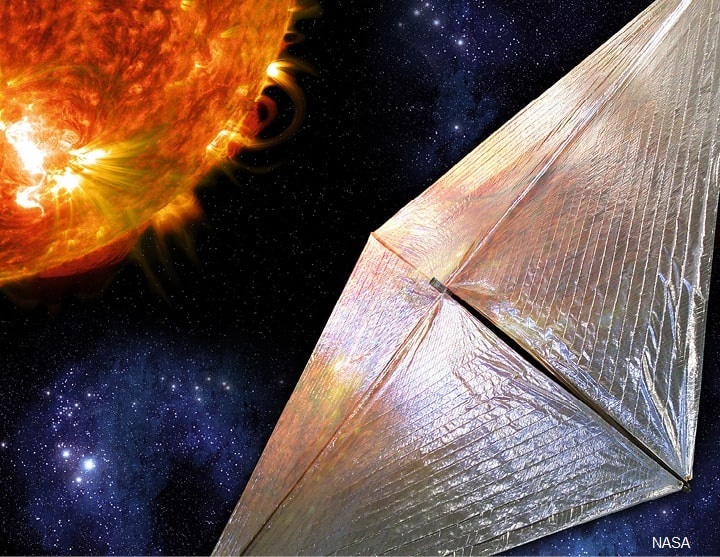 Artist’s concept showing Solar Cruiser and the Sun.
Artist’s concept showing Solar Cruiser and the Sun.
Sustainable option
The O’Neillian alternative to atmospheric geoengineering is to reduce the amount of solar energy that reaches Earth in the first place. This can be accomplished with a planetary sunshade. A planetary sunshade is a large constellation of thin film structures that sit between the Earth and the Sun to reduce incoming solar energy by approximately one percent. The exact reduction is variable depending on how long it takes to cease carbon emissions, how quickly carbon can be removed from the atmosphere, and whether society wishes to partially mitigate global warming or restore pre-industrial temperatures. A planetary sunshade is a sustainable alternative to atmospheric geoengineering, and could offer a safe wind-down strategy should atmospheric geoengineering ever be deployed.
The ideal location for a planetary sunshade is at Sun-Earth Lagrange Point 1 (SEL-1). This is an unstable equilibrium point between the Earth and the Sun, about 1.5 million km sunward of Earth, where the gravitational effects of the Earth and Sun cancel each other out. Thin film structures are also affected by solar radiation pressure, which displaces the equilibrium point sunward of SEL-1; minimum mass architectures orbit at 2.36 million km from Earth.
Over the last decade, solar sailing has evolved from theory to established practice
Depending on the desired reduction in solar radiation and the properties of the sunshade itself (such as areal mass and reflectivity of the thin film material), the sunshade would need to have a total area of 1 million to 4 million km2. The sunshade can maintain its orbital location through the use of solar sailing.
The idea of a planetary sunshade is not new. First proposed in 1989 by James Early, three decades of subsequent academic research have yielded basic results on minimum mass constraints, control laws for propellant-less station-keeping using photon pressure, trajectories for deployment to the SEL-1 region, and several potential architectures for how a sunshade would be built and deployed.
The Geoengineering Model Intercomparison Project (GeoMIP) consortium of climate modellers maintains solar dimming models representative of a sunshade world, alongside models of atmospheric geoengineering. Under either technology, average global temperatures can be effectively limited. While ocean acidification is not addressed, and residual temperature and precipitation variations would remain, the benefits appear to outweigh the risks of unmitigated global warming.
There are two main architecture approaches for how a planetary sunshade could be constructed and deployed: built and launched from Earth, or manufactured in space from lunar and/or asteroid materials. The scope and scale of the sunshade is large enough that both architectures can be utilised. As the climate crisis worsens, if the decision is made to deploy space-based SRM, the initial emphasis will be on rapid deployment.
Since the infrastructure to extract space resources and build large structures in orbit does not currently exist and likely won’t until mid-century, the first sunshades deployed will probably be built on Earth. SpaceX’s design goals for Starship, its reusable super heavy-lift launch vehicle, and logistical requirements for a city on Mars leave enough slack capacity between Mars launch windows to support meaningful deployment of a planetary sunshade. Other rapidly reusable launch architectures could also support sunshade deployment.
Terrestrially-launched sunshades require only modest advances in technology and could be deployed relatively quickly once a decision is made to proceed with space-based SRM. Over the last decade, solar sailing has evolved from theory to established practice, and in 2025 NASA will launch Solar Cruiser, a solar sail that will serendipitously demonstrate station-keeping manoeuvres at SEL-1. Continued scaling of sail size toward kilometre-size diameters can enable mass production at industrially familiar scales, akin to the automotive or aircraft industries.
While the initial generation of sunshades will likely be built on and launched from Earth, deploying an entire sunshade from Earth would take hundreds of thousands of rocket launches, spread over decades of sunshade deployment time.
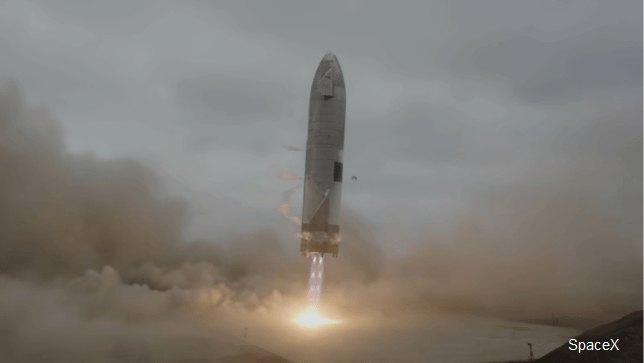 SpaceX’s reusable super heavy-lift launch Starship (prototype SN15) successfully lands after a high-altitude flight test on 5 May 2021. Starship, and other rapidly reusable launchers, could support deployment of multiple sunshades.
SpaceX’s reusable super heavy-lift launch Starship (prototype SN15) successfully lands after a high-altitude flight test on 5 May 2021. Starship, and other rapidly reusable launchers, could support deployment of multiple sunshades.
Building in space
With the infrastructure necessary to build a sunshade from space resources, the possibilities for societal and economic growth become nearly infinite
The environmental impacts of constructing, transporting, and launching these vehicles need to be studied in depth. While terrestrially-produced shades are a critical component of the sunshade architecture due to the speed with which they can be deployed, it is likely that a more efficient, greener solution will be developed to complete the full sunshade. This is where the use of space resources becomes crucial, and where the sunshade begins to fulfil O’Neill’s vision.
The transition from terrestrially-launched to space-built sunshades would likely occur slowly and in concert with other initiatives already underway around the world. The first step would be sunshades assembled on-orbit from Earth-launched components. Then, Earth-launched membranes could be installed on trusses additively-manufactured in space; these structures can be arbitrarily large since they will not have to fit inside a launch vehicle. These efforts can evolve from existing on-orbit servicing, assembly, and manufacturing (OSAM) initiatives currently underway around the world, particularly at NASA and within the aerospace industry.
Eventually, the resources of the Moon would be incorporated into the architecture. Although resources from asteroids are also a viable option (and indeed may be better from an orbital mechanics perspective), lunar resources will certainly be the first utilised due to Apollo-era knowledge of lunar resources and current international efforts, led by civil space agencies, to establish a sustainable human presence on the Moon.
For the sunshade, viable lunar resources include aluminium and/or titanium extracted from lunar regolith; these lightweight metals can be transported from the lunar surface to an orbital manufacturing facility, while heavier metals such as iron and volatiles such as water from the lunar poles can be used to support lunar surface infrastructure.
To support this level of activity in space, thousands of people will live on the Moon and in deep space, providing oversight, performing maintenance, and generally improving the capability of extraction and manufacturing machines. As with any frontier, the standard of living will improve as more people arrive and the idea of living and working in space becomes normalised.
With the infrastructure necessary to build a sunshade from space resources, the possibilities for societal and economic growth become nearly infinite. If the sunshade were constructed from thin-film photovoltaics, it could produce terawatts of energy and demonstrate the feasibility of constructing a type II civilization (capable of harnessing the energy radiated by its own star – Kardashev scale). This energy could be beamed to a fleet of Earth-orbiting satellites for safe relay to Earth’s surface, providing limitless, clean energy as O’Neill outlined in the 1970s. The power could also be beamed to the lunar surface to provide energy during the long lunar night, or it could be used in situ to power incredible orbital manufacturing capabilities.
O’Neill cylinders also become a real possibility, providing spacious, Earth-like comfort for humans who choose to migrate up the gravity well into space. Once humans can live sustainably in near-Earth space, settlement farther into the solar system, and even beyond, becomes achievable. Humans will have truly become a spacefaring civilization.
For those concerned about the existential risks of the climate crisis and interested in building a future in space, based on sustaining Earth’s precious environment, we invite you to connect with the global sunshade research community by getting in touch through our website at https://planetarysunshade.org. We hold weekly collaboration calls and occasional workshops to develop architectural concepts and technology demonstration proposals, and particularly welcome participation from climate-impacted communities and emerging space-faring nations.
Our climate future will look like nothing in human history, but as the O’Neillians recognised a generation ago, we can break the limits to growth by going to space, for the benefit and in the interests of all humanity, to build solutions for Earth’s greatest challenges.
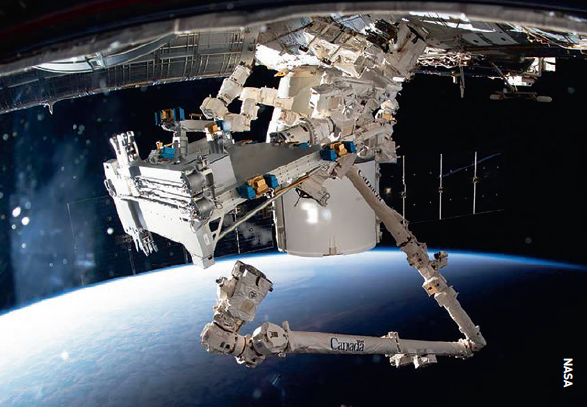 The Canadarm2 robotic arm and Dextre extract the Bartolomeo platform planned to be used as an on-orbit factory in the PERASPERA In-Orbit Demonstration (PERIOD) project. The two-year project focuses on satellite assembly and manufacturing in orbit with the objective to continue with a demonstrator in orbit.
The Canadarm2 robotic arm and Dextre extract the Bartolomeo platform planned to be used as an on-orbit factory in the PERASPERA In-Orbit Demonstration (PERIOD) project. The two-year project focuses on satellite assembly and manufacturing in orbit with the objective to continue with a demonstrator in orbit.
About the author
Liz Scott is the Research Director of the Planetary Sunshade Foundation, a nonprofit organisation dedicated to developing space technologies for climate restoration. She is also a PhD candidate at Colorado School of Mines in the Space Resources programme. Previously, Liz was the Certified Responsible Engineer for the Atlas V payload fairing at United Launch Alliance.





